Cimetière de Montmartre, in Paris’ 18th arrondissement, did not have the most glamorous or auspicious of beginnings. It was originally a gypsum quarry, situated outside of the city walls, and after the quarry was abandoned, a section of it was used as a mass grave during the turbulent years of the 1790s. Yet this rather grim location was over time transformed, and it is now a peaceful haven where thousands of Parisians lie at rest beneath beautiful memorials.

Montmartre was the first Parisian cemetery I visited on a recent trip, fresh off the Eurostar and perked up on strong coffee after an early start to the day. Its location in an abandoned quarry means that the cemetery is several metres below street level, and it is crossed by the Rue de Caulaincourt, which leaps over the cemetery on a massive metal bridge which was constructed in the 1880s. On either side of the bridge, tombs and gravestones are visible – the bridge carries the living over a city of the dead. Visitors must descend a flight of steps to find the cemetery’s entrance on Avenue Rachel.

The cemetery’s original name was la Cimetière des Grandes Carrières – Cemetery of the Large Quarries – a nod to the site’s original use. The quarrying of gypsum had been taking place in the Montmartre area since the medieval period – stucco is sometimes called “plaster of Paris” due to gypsum being one of its main ingredients. The old quarry that became Montmartre Cemetery is not the only mining site to become a resting place for Paris’ dead – the city’s famous catacombs, where the bones of over six million Parisians are stored in a vast subterranean ossuary, were once limestone mines.

The cemetery was officially opened in January 1825, the last of four cemeteries opened on the edges of the city in the early part of the 19th Century. At the time the cemetery opened, the district of Montmartre was still officially outside the city limits of Paris, only being incorporated as the 18th arrondissement in 1860. The closure of the ancient burial grounds within the city walls at the end of the 18th Century – most famously including the clearing of the grossly overcrowded Cimetière des Saints-Innocents – had led to a demand for decent, affordable cemeteries for Paris’ dead. Along with the cemeteries of Passy, Montparnasse and the world-famous Père Lachaise, Montmartre’s cemetery was able to provide a dignified final resting place for residents of the surrounding districts.


The entrance to the cemetery is under the bridge that carries the Rue de Caulaincourt over the site, and visitors are greeted with a slightly strange scene – grand tombs nestled beneath the iron struts and pillars of the bridge.


Once out of the shadows cast by the bridge, the path between the tombs widens out into a broad circle, around which many grand memorials are situated. One of the most famous of these is the grave of the Zola family, with its bust of author Émile Zola. Zola was a celebrated novelist and journalist who is most famous for his 1898 “J’accuse…!” headline published during the Dreyfus Affair, the long-running scandal of a French-Jewish officer who was falsely accused and convicted of treason, despite there being no evidence to prove his guilt. Zola’s challenges to the French media’s antisemitism helped to gain support for Dreyfus, who was eventually pardoned. Zola’s death in 1902 from carbon monoxide poisoning has long been rumoured to have been murder due to his involvement in the Dreyfus Affair. Although in 1908 Zola’s remains were moved to the Panthéon, where many illustrious French cultural and political figures are commemorated, his family members remain in their original grave at Montmartre.
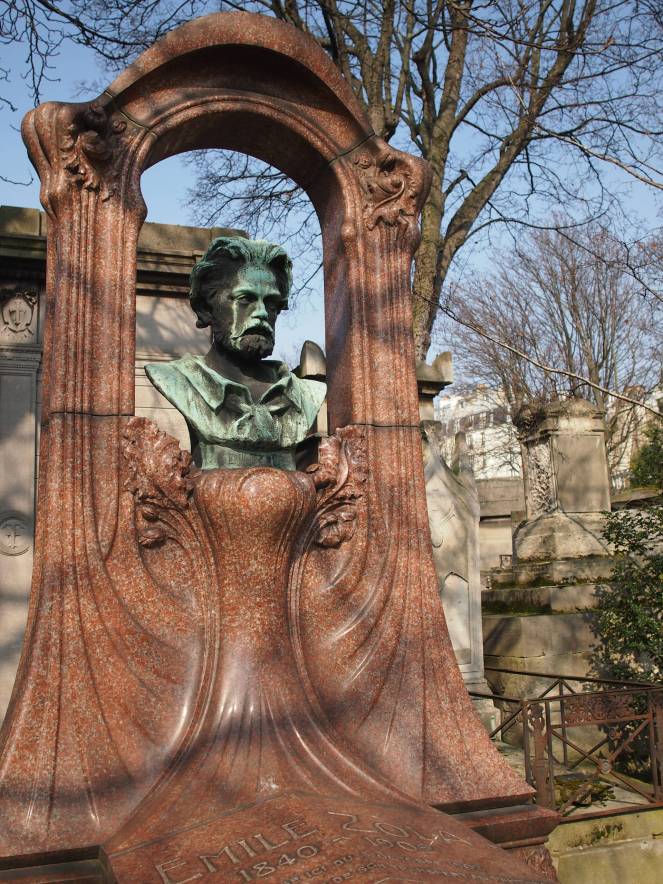
Montmartre Cemetery incorporates all sorts of artistic and funerary styles, from plain headstones to grand monuments adorned with fin de siècle or art nouveau flourishes, but the most prevalent type of memorial is the little mausoleum, about the size of a phone box, which typically includes space inside for memorial tablets, flowers and perhaps religious items. They function as tiny private chapels, sometimes commemorating several generations of the same family.




There are some incredibly beautiful statues and sculptures to be found at Montmartre. Albert Bartholomé, the artist and sculptor whose masterpiece is the wonderful Monument aux Morts at Père Lachaise, sculpted some of the memorials at Montmartre, mournful figures with gracefully draped clothing. Two of his works are pictured below, and they are easily as beautiful as the many Bartholomé creations found in museums today.



The Egyptian Revival, which was also popular in Britain and America in the early decades of the 19th Century, is also represented at Montmartre. Two figures in distinctive ancient Egyptian headdresses flank the iron door of an old mausoleum.

The late 19th Century ushered in Paris’ Belle Époque (“beautiful era”), and many artists, writers and musicians gathered in Montmartre, with some of them later being laid to rest in Cimetière de Montmartre or the nearby Cimetière Saint-Vincent. One of the many artistic figures buried at Montmartre is Edgar Degas (1834-1917), most famous for his paintings of ballerinas and ordinary Parisians.


Vaslav Nijinsky was one of the most celebrated male dancers of the early 20th Century. Russian by birth, he danced for the Imperial Ballet in St Petersburg before joining the Ballets Russes in 1909. As well as his expressive and intense performances as a dancer, he was also a gifted choreographer, famous for original and provocative dances. He was dismissed from the Ballets Russes in 1913 after his marriage to Romola de Pulszky caused a permanent rift with Ballets Russes founder Sergei Diaghilev, who had been Nijinsky’s lover. The First World War saw Nijinsky held under house arrest for a time in Hungary, and after the war his mental health declined alarmingly. Tragically, he was to spend most of the last 30 years of his life in psychiatric institutions – he never danced again in public, dying in London in 1950. He was originally buried in London, but in 1953 his remains were moved to Montmartre and dancer Serge Lifar donated the statue of Nijinsky as the puppet Petrushka that now adorns his grave.

The images on the grave of Ambroise Louis Garnery give the visitor a glimpse into what was quite an extraordinary and rather dramatic life. He was a gifted painter and writer, and also served as a corsair, a privateer authorised by the French government to attack the ships of nations at war with France. He served under the famous corsairs Jean-Marie Dutertre and Robert Surcouf, and after being captured in 1806 he was held as a prisoner in England for eight years. During this time, he was able to improve his life behind bars by selling his paintings. He later became an official painter of the French Navy and produced many paintings of ships and maritime scenes. He also published memoirs of his life as a corsair, which made him famous after his death in 1857.

As well as being the resting place of many great figures of the arts, Montmartre is home to one of France’s most famous scientists – Léon Foucault. Foucault is best known for his demonstration of the Foucault pendulum, which provided proof of the earth’s rotation. The most famous Foucault pendulum can still be seen today in the Paris Panthéon.

Unlike many large British cemeteries, where different sections – some consecrated, others unconsecrated – catered for adherents of different religions and denominations, people of all faiths and none rest alongside each other at Montmartre. Although one section in particular is dominated by Jewish graves, there appears to be no strict segregation along religious lines. Despite the overall secular nature of the cemetery, though, many individual graves incorporate religious symbolism that reflects the faith of the people they commemorate.
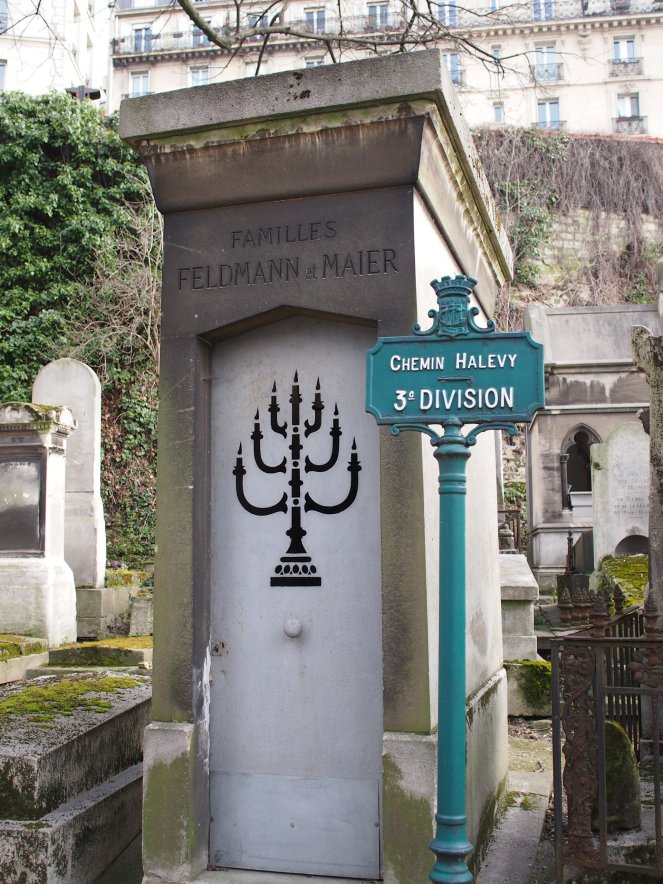
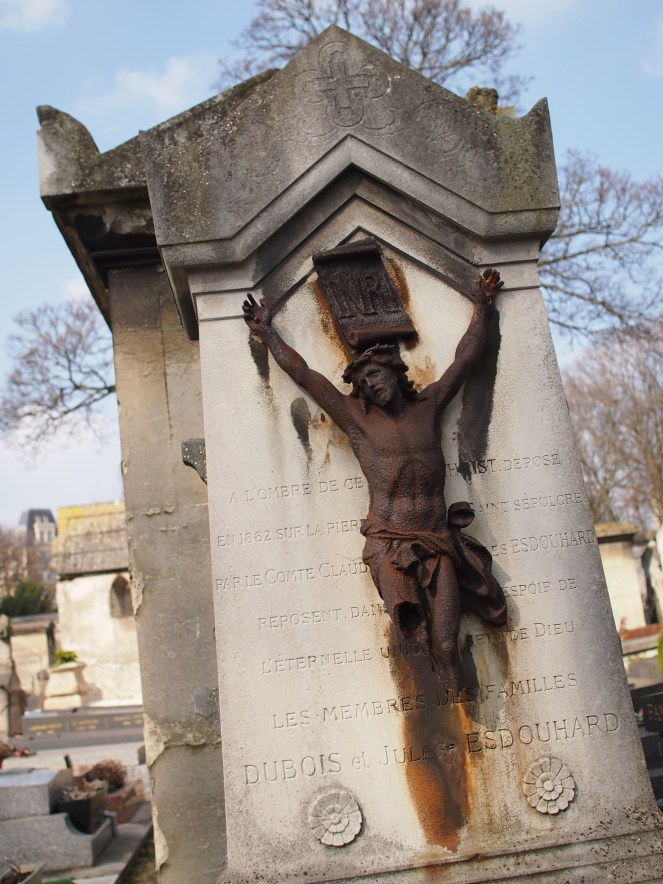


The pictures included in this article are only a small fraction of those I took during my visit to Montmatre cemetery – there are over 20,000 burial plots on the site, and so many beautiful and meaningful memorials. Although my French isn’t good enough for me to be able to understand much of what was written in the inscriptions, many of the symbols used on the graves were familiar to me – as well as overtly religious symbols, familiar signifiers of death such as the winged hourglass and the downturned torch were present on many memorials. 

The memorials at Montmartre are of all ages, some almost 200 years old, others modern. Mourners often leave ceramic wreaths and crosses on graves, items that last much longer than flowers. The cemetery is beautifully kept, with few signs of vandalism and most monuments looking fairly intact and safe. Perhaps the preference for the little mausolea and flat tombstones has helped – these monuments don’t topple as easily as the headstones that are more popular in British cemeteries.
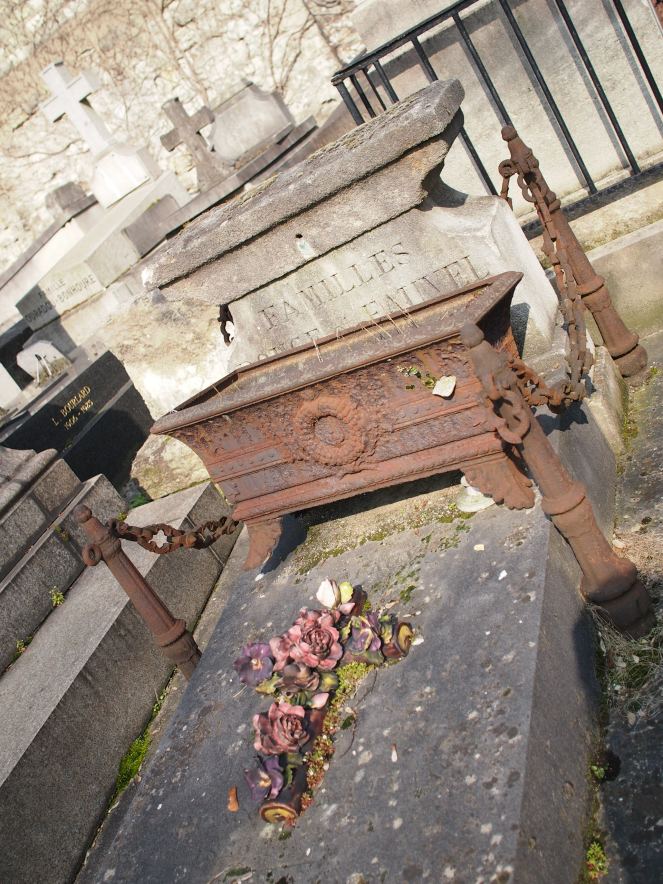

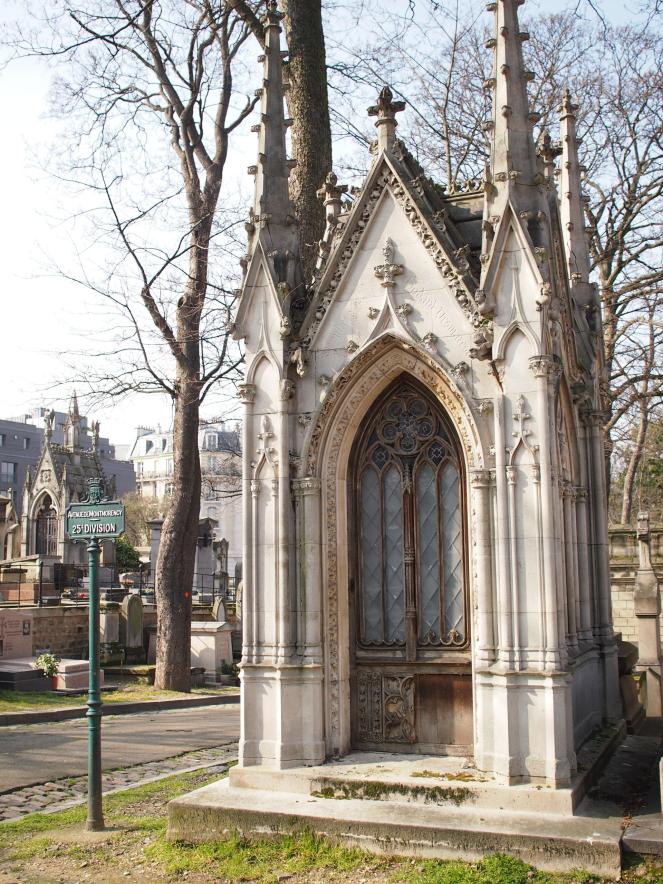
I spent a fascinating morning exploring this beautiful cemetery, and although not as famous as Père Lachaise (which Flickering Lamps will be visiting in an upcoming article), it is still popular with tourists for the many beautiful memorials it contains and the insights it provides into the lives of those who have lived and died in Paris over the last two centuries. The cemetery is open daily, and visitors can pick up a map of the cemetery from the entrance lodge.

References and further reading
Montmartre Cemetery in Paris, France http://www.ila-chateau.com/paris/montmartre-cemetery.htm
Montmartre Cemetery – Atlas Obscura http://www.atlasobscura.com/places/montmartre-cemetery
Legendary Vaslav Nijinsky – Russian Ballet History http://www.russianballethistory.com/nijinskythelegend.htm
Corsair, Painter, Writier: Ambroise Louis Garnerey – Patrick von Stutenzee’s History Blog http://stutenzeehistoryblog.blogspot.co.uk/2012/11/corsair-painter-writer-ambroise-louis.html


Fascinating insight, and great photos. Thanks for giving me an idea where to drag my missus, revered aged one, and old friend, on my honeymoon! After nearly 5 years living in the north, in the 59, Chez les Ch’tis, finally visiting Paris, thanks to my dad, in April, and staying not far from this. Bon weekend biloute, et bon paques!
LikeLike
Fantastic! And I especially love your second photo, the one featuring the Grandjean tomb with the buildings of current, living Paris looming above it. Beautiful juxtaposition and more than a bit profound 🙂
LikeLike
It’s a beautiful cemetery, and I loved learning more about it! That puppet statue is definitely kind of sinister looking though…I wouldn’t want to be left alone with him at night!
LikeLike
Lovely photos and good to find out more about its history which I did not know. The cats look like they are thriving!
LikeLike
I was wondering if I could find it on my first ever visit to Paris (other than Roissy Airport), despite living in the north in the 59 for nearly 5 years. The friend who helped my revered aged one book the hotel rooms asked for a quiet room for my dad. Sure enough his room could not have had quieter neighbours – it overlooked this very cemetery! Amazing sight.
LikeLike
Lovely to see this. Memories! In 1991, my mother and I lodged at the Hotel Mercure next door to this cemetery when our reservations in another arrondissement got messed up. This mistake turned out to be most fortunate, as we had a wonderful time exploring the Cimetiere Montmartre. We even ended up in film by some French students who had us lead them to Truffaut’s grave! (And that night I ended up onstage at the Moulin Rouge, but that’s a whole ‘nuther story . . . )
LikeLike
Thanks so much for your extremely interesting, informative blog with all those wonderful photos. Wish I had read it prior to a trip my husband & I made to Montmartre. We rented an apartment on Avenue Junot & the cemetary was where I took my morning walks. Very scenic & peaceful place with an intriguing history. Really enjoyed seeing the cats as well. I much prefer it to Pere Lachaise.
LikeLike